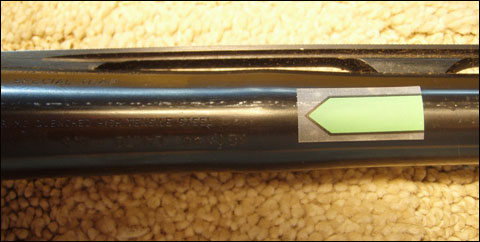Beware of Shoddy Barrel Modifications — Part 1

In my last two columns we examined damage to shotguns that can occur from shooting excess pressure loads (January 2014) and from barrel obstructions (February 2014). In this installment let’s begin looking at barrel damage that can occur from improperly performed barrel modifications.
First a definition of terms is in order. A barrel modification is ANY after-market work done to a shotgun barrel by other than the barrel’s original manufacturer. Such modifications include but are not limited to chamber and/or forcing cone lengthening, backboring, porting, screw-in choke installation, and sleeving.
Many of these are quite popular these days because competitive clay target shooters in particular have convinced themselves that several of these modifications are automatically necessary for any shotgun barrel to be state of the art. Be advised and recognize that every single one of these barrel modifications when performed after-market void the barrel’s warranty. So unless done carefully and correctly, this spells potential trouble. Here’s why…
In engineering terms, a shotgun barrel is a tubular structure. The materials used in the construction of a tubular structure plus its wall thickness (in the case of shotgun barrels) combine to equal the structure’s strength against internal pressure-caused bulges, fractures or bursts. While the above barrel modifications do not change the original materials (steel) used in the barrel’s construction, they all definitely impact wall thickness. In short, they all involve removing metal from the wall thickness of the barrel. And any time wall thickness is reduced in a tubular structure, its strength is reduced. This is an inescapable engineering fact.
Therefore, think carefully before you turn your expensive shotgun barrel over to someone to lengthen the chamber or forcing cone (both involve reaming to remove metal precisely at the point in the barrel where pressures are highest), to be “backbored” to result in a larger internal diameter (more reaming and metal removal), to install ports (significant metal removal resulting in a series of holes all the way through the barrel walls) or for screw-in choke installation (significant reaming and metal removal followed by thread reaming at the muzzle end of the barrel where there is the second highest pressure spike).
You want to be certain or pray piously every night that the individual undertaking this work does so correctly and performs any reaming absolutely parallel to the axis of the bore. In short, none of these procedures are simple and all of them require fairly sophisticated machining tools and skills. And the reality is all of them can be botched.
 Even high quality barrels can be damaged by improperly performed barrel modifications. This Beretta 303 Special Trap barrel made with quenched high-tensile steel bulged forward of the chamber area from normal target loads after an excessively long forcing cone was reamed crooked which removed critical wall thickness in the bore proper.
Even high quality barrels can be damaged by improperly performed barrel modifications. This Beretta 303 Special Trap barrel made with quenched high-tensile steel bulged forward of the chamber area from normal target loads after an excessively long forcing cone was reamed crooked which removed critical wall thickness in the bore proper.Refer now to the photo accompanying this column. While it’s not ultra-clear in the photo, there is about a ½-inch-long, .091-inch diameter bulge in one side of the barrel a couple inches forward of the chamber area. This bulge occurred when shooting perfectly normal factory lead target loads in the barrel after it was sent off to a gunsmithing service to have the forcing cone lengthened by three inches. Forcing cones commence right at the forward end of the chamber. While the pressure generated by any given shotshell load is always highest in the chamber and diminishes as the ejecta moves down-barrel until it reaches the choke where pressure again spikes somewhat, there is still significant pressure remaining in the forcing cone area of any shotgun barrel.
The trouble here is that the barrel jockey lengthening the forcing cone reamed it crooked. This resulted in an excessive amount of metal being taken out of one side of the barrel in the area of the bore proper where the wall thickness is already thinner than in either the chamber or forcing cone area. The wall thickness at the end of the ream was thinned and weakened sufficiently that the pressure generated by even a normal factory load was great enough to cause the barrel to bulge. Since there is nothing to be gained by an excessively long forcing cone anyway (anything longer than 1½ inches), the longer the attempted ream the more metal removed and the greater the chance that it will be done slightly, or as in this case, very crooked.
A closely related problem which can result in a split or bulge at the forward end of the chamber occurs when an uninformed gunsmith and the barrel’s owner elect to lengthen the chamber to accept a longer length shell. The fact is the wall thickness in the chamber area of any shotgun barrel is always greater than the wall thickness in the forcing cone and bore proper of the same barrel. This is necessary to withstand the very high pressures that occur in the chamber which always decrease down-barrel as the ejecta moves forward.
Trouble is, some chamber areas of some shotgun barrels do not have a sufficiently long length of extra wall thickness in the chamber region to encase a shell length longer than that for which the barrel was originally chambered. Removing metal to lengthen the chamber in such barrels results in cutting into the forcing cone area of the barrel which by virtue of the thinner walls there means the forcing cone area will be significantly weakened. The result when the level of pressure that occurs in the strong chamber area enters the weaker forcing cone area is that the bulge illustrated in the photo can then occur 360 degrees in the forcing cone even if the chamber lengthening is done perfectly straight.
All of the pluses and minuses of barrel modifications are covered in my 75-page book Tom Roster’s Shotgun Barrel Modification Manual. Next month we’ll look at barrel damage that can result from faulty backboring, porting, and screw-in choke installation.
Copyright 2014 by Tom Roster. All Rights Reserved. This material may not be published, broadcast, rewritten or redistributed. To correspond with Tom Roster or to order his reloading manual on buffered lead and bismuth shotshells, his HEVI-Shot reloading manual, his updated 75-page Shotgun Barrel Modification Manual or his instructional shooting DVD, contact him at 1190 Lynnewood, Blvd., Klamath Falls, OR 97601. You can reach him by phone at 541-884-2974 or email him at tomroster@charter.net.

Tom Roster is an independent ballistics consultant and author specializing in the design and testing of shotshell loads for U.S. shotshell and reloading components manufacturers. He is a court-recognized shotshell/shotgun expert witness. Tom was formerly the Ballistics Research Director at Oregon Institute of Technology and then served as a Ballistics Specialist for the Dept. of the Interior. In these capacities he designed and administered the world’s six most extensive lead versus nontoxic shot duck, goose, pheasant and dove shooting tests ever conducted. He then co-authored their peer-reviewed scientific reports. Roster spends about 100 days afield each year testing lead and nontoxic hunting and target shotshell loads, then traveling worldwide reporting on his findings to industry and wildlife professionals, hunters and shooters, and in his writings for various shotgunning magazines. Contact him in Oregon at (541) 884-2974, tomroster@charter.net.


Comments